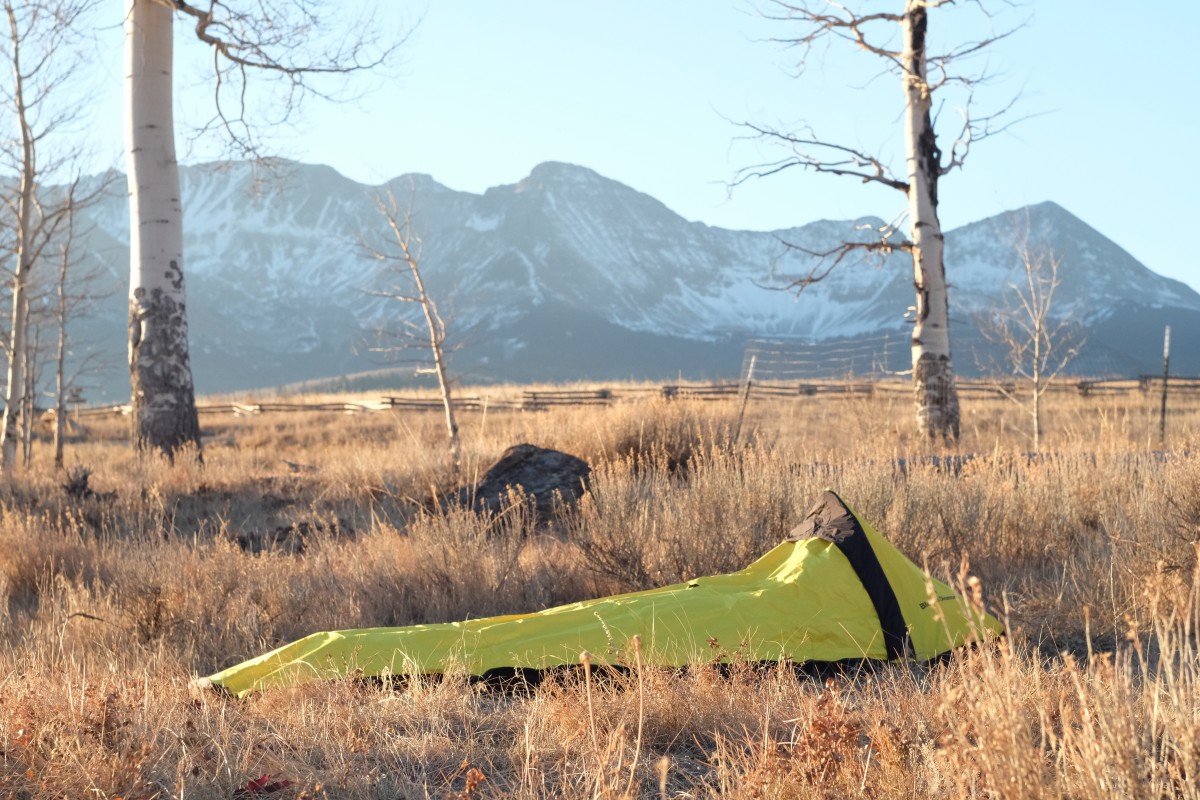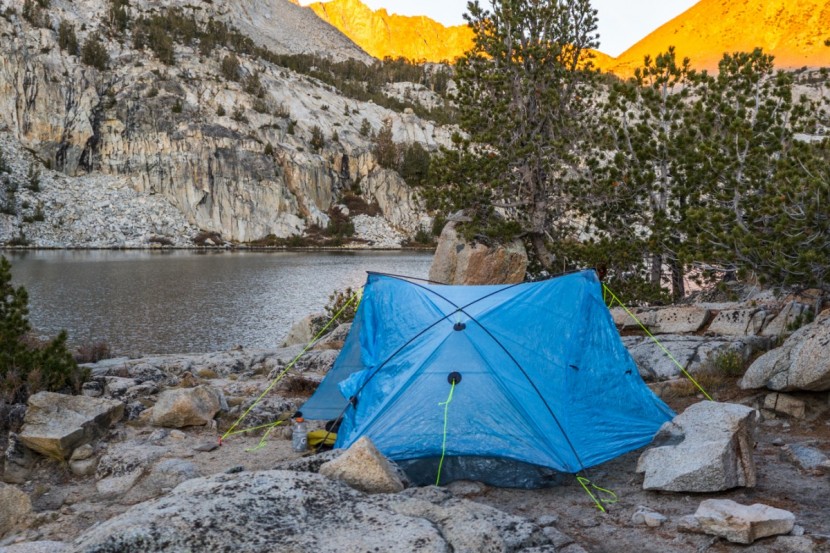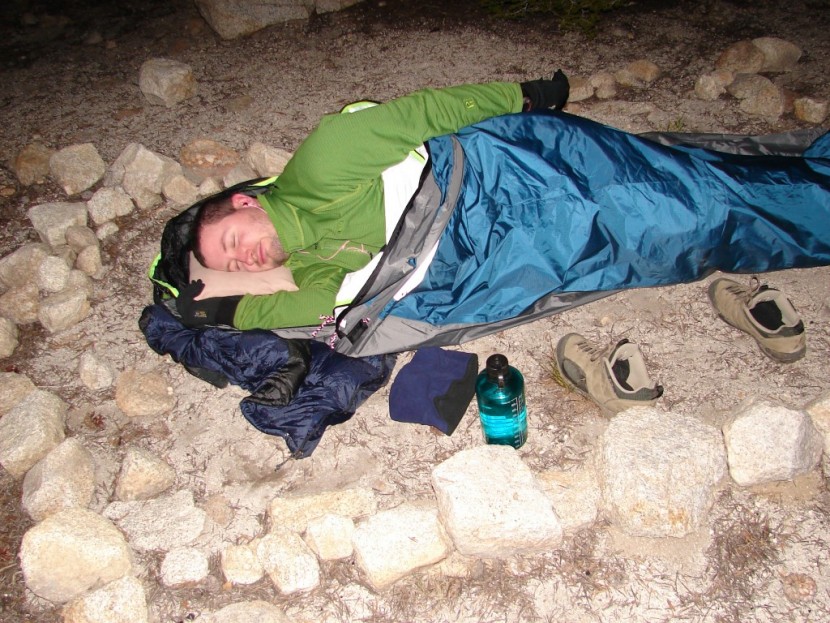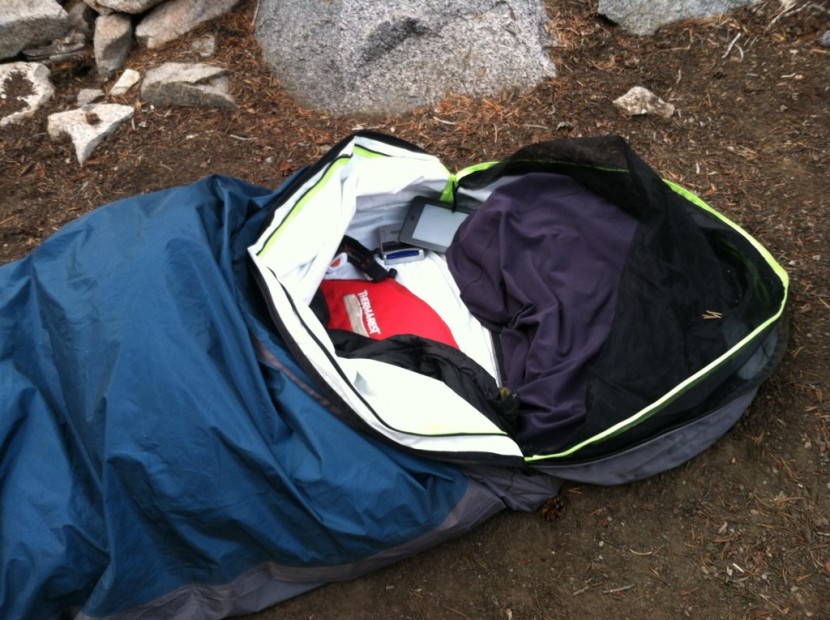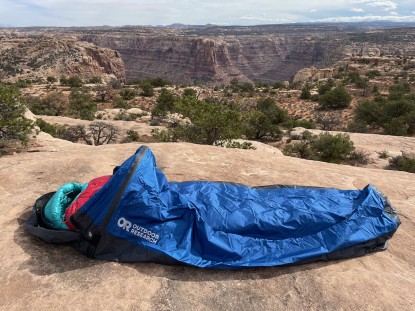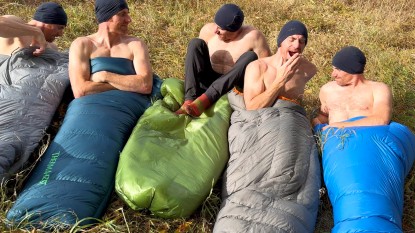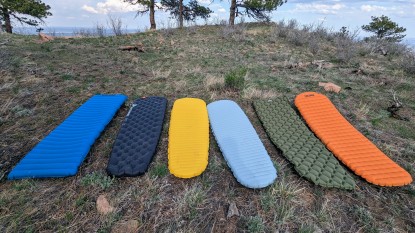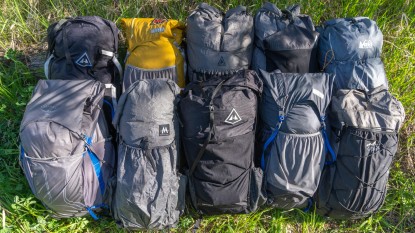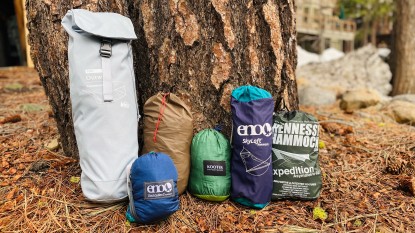Considering a bivy sack? While the idea of zipping yourself up inside a nylon sack for the night might seem daunting or uncomfortable, the opposite can be true - a bivy sack can be a comfortable, lightweight, smaller alternative to a tent and can be just as waterproof and durable. This might sound like the best thing since down insulation, but a few things must be kept in mind — each model isn't ideal in every situation, and some are downright inappropriate in the wrong climate or weather conditions. In this article, we discuss the types of bivys on the market, what each of them does best, and how you can decide on the perfect system for your next adventure in the great outdoors.
Why Use a Bivy Sack?
The original idea of a bivy, or bivouac sack, was a lightweight and small option that could provide emergency shelter and warmth when conditions demanded it. Users of bivys have always sacrificed comfort for the sake of reduced weight and small packing size. Early bivies were simple waterproof sleeping bag covers that would keep the rain off but were plagued with condensation issues inside the bag. Modern bivys utilize lightweight materials that provide water protection while remaining moderately breathable to reduce condensation issues.
We have much higher expectations from the bivy sacks of today. The highly refined designs and available waterproof, breathable materials open up the possibilities. There is also a spectrum of bivys, from ultra-weatherproof, expedition-worthy to ultralight bivys reserved for emergencies.
However, a bivy is not for everyone, and today, they face stiff competition from ultralight tents and tarps, which all have their niche in the outdoor shelter market. See our Ultralight Tent Review for more info on the best ultralight tents and tarps.
Related: The Best Ultralight Tents
An ultralight tent, especially a two-person tent that weighs under two pounds, can provide two people with a much more comfortable shelter and better weather and bug protection. An ultralight tarp is another option, and a two-person tarp may be lighter still, and may offer better rain protection than some bivys.
So, why use a bivy at all?
Pros
- Lightweight — When compared to a traditional tent, bivys are almost universally lighter for the price and protection you get. However, ultralight tents and tarps can offer solutions with similar or even less weight, especially if you're in a group of two and can split the load.
- Small Packed Size — The small packed size allows you to take an even smaller backpack than you might normally take. Some individuals even leave their sleeping bag inside the bivy and pack it as such. This lets you deploy your sleeping system in only a few seconds.
- Small Footprint – You can make a bivy work in many places where a tent will not — high rock ledges, tight snow caves, tiny flat campsites on rocky terrain.
- Simplicity — Setting up a bivy can take only a few seconds, whereas erecting a tarp or ultralight tent can take maybe ten minutes. Consider the amount of time it takes for cold fingers to stake out guy lines or get poles set up just right. The moment the sleeping bag is in the bivy, you're good to go.
- Warmer sleeping — A bivy can improve the effective temperature range of a sleeping bag by as much as 5°F. Some ultralight hikers use this capability strategically, allowing them to use a lighter sleeping bag and thus shave off weight from their overall pack weight. Keep this in mind as a low-weight solution to colder climates when you don't want to buy a bigger, bulkier sleeping bag. The smaller options sometimes offer excellent warmth at a fraction of the weight and cost of a bigger sleeping bag.
- Four-season — Bivys can offer better winter performance than many competing ultralight tent solutions.
Cons
- No room, poor comfort — A tent offers the ability to sit up and have your morning coffee with your stuff inside. Not so with most emergency bivys and some of the larger ones, too. In sustained weather, a tent is a much better place to wait out a storm. Check the weather before you go; if inclement weather is imminent, a tent or tarp with more coverage might be your best bet. That being said, if you're going light and are armed with a roomy, highly weather-resistant option, you might be able to cram everything inside. Do a “Dry” run before you go.
- Solo only — If you had two or more people, an ultralight tent would typically offer a better solution than two bivys when you add up the weight and size. That said, if you have multiple people and utilize a tarp, having emergency-style bivys along can augment the tarp and offer extra warmth and protection in nasty storms and cold weather.
- Not great in sustained rain — Some bivys have an opening for breathing at the top that is not fully covered (in fact, it needs to be a bit open to provide proper air). You can roll over and sleep on your stomach to prevent rain from coming in or put a jacket over your head. Some ultralight enthusiasts use a tarp in combination, which can provide a much better solution in the rain than a bivy alone.
- Bug protection — Only a few bivys offer bug netting, and none offer a comfortable place to hang out protected from the bugs. Again, if you're traveling through an extremely buggy environment, consider bringing along a tent or an ultralight tarp with a bug net. These options will keep you happy and offer a bedbug-free night.
- Condensation — It is nearly impossible to completely avoid condensation buildup inside a bivy sack. That being said, some bivy sacks are more breathable than others, which can significantly minimize the buildup of condensation inside a bivy sack during the night. In fact, in very dry climates, like the desert southwest, if the zipper is left open with a highly breathable bivy sack, you might not notice any condensation and wake up as a happy camper.
The bottom line here is to make sure you consider ultralight tent and tarp shelters as legitimate ways to deliver low weight and small packed size before you finalize your purchase decision. The use of a tarp is often combined with bivys to create a more complete lightweight solution-- the tarp provides rain protection and added comfort, and the bivy protects from rain splashes and wind-blown spray, as well as acting as a groundsheet.
Selecting the Right Bivy
Each product in our Bivy Sack Review does something well but has some qualities that aren't designed or ideal for other situations. As it is with most outdoor gear selections, it's important to have a clear idea of what you're going to use this piece of equipment for before diving into the specific characteristics of each bag. Do you need a little extra warmth at night? Are you going to be sleeping in snow caves or weathering heavy rain? How important is weight in the calculation? Having even a general idea in mind will help guide you to the ideal bivy for you.
Where Will You Be Taking It?
A bivy sack can be a wonderful product because of its versatility. Whether high in cold mountains or a summer meadow, a bivy provides a lighter-weight alternative shelter. What you are sheltering from becomes the variable to consider before choosing the best product for your needs. Will mosquitoes be in full bloom? Are thunderstorms predicted or even likely? How warm (or not) are the temps predicted to be, and how much warmer will that sack make a sleeping bag? We've broken down the most important metrics for scoring the ideal sack and discussed them in our review, as well as which environments are ideal for each one.
Types of Bivy Sacks
In our review, we examined different bivy sacks to find the one that performed the best overall. We focused primarily on weatherproof models with reliable construction, but that's not the only kind of bivy you'll find out there. Bivys typically come in a few styles:
Emergency
These bivys are designed to disappear into your pack only to emerge when an unplanned bivy is necessary. Some are semi-reusable, inexpensive, emergency bivies. They protect you during critical times when a shelter is needed but can't necessarily be relied on to provide shelter day after day because of durability and functionality reasons.
Minimalist Models
Ultra-lightweight, simple, and constructed without poles or extra features that increase weight and bulk, three-season minimalist models are ideal for most applications. If you are an occasional backpacker who is looking to shed some weight and you don't usually take trips in the winter or during raging thunderstorms, this is the model you will most likely want. These models offer protection from occasional weather and insects in the lightest and smallest packages available. As a bonus, they are usually reasonably priced.
Four-Season Models
These are highly weather-resistant models. They typically have some form of wire or pole to keep the fabric off of your face and are generally made of very strong materials to increase their durability and withstand repeated abuse. These can be used year-round and are ideal for winter camping or in situations where protection from the elements is essential. They are typically heavier than minimalist models but usually more comfortable, especially when the weather is bad or temps are low. These models are normally more expensive than other bivy types. The price can rival that of a one-person backpacking tent. However, a bivy is usually still lighter and more compact than a tent.
Key Accessories
While bivys are a stand-alone product, we always recommend adding a few items for any overnight camping trip, such as a sleeping pad and an appropriately warm sleeping bag. Together, these pieces increase comfort and allow for a safe night in the event of unforeseen weather or chilling cold.
Sleeping Pad
If you have recently wandered into an REI, you will know there are about one million different sleeping pads available. For the sake of this article, we advise using a pad that matches your mission and bivy you have decided to take. We always lean towards the inflatable pads as they offer a better night's sleep without causing hip or shoulder pain. A valuable tip for those traveling in pokey territory with inflatable pads; put 3 to 5 ounces of Stans tubeless bike tire sealant into your sleeping pad. It is incredibly effective at sealing the little desert pokes without having to get out the repair kit. The lighter model bivys should be paired with lighter pads, while four-season and winter bivys are best paired with a warm and durable model that can hold up in similar terrain. For more information on sleeping pads, check out our Best Sleeping Pad Review.
Related: Best Backpacking Sleeping Pads of 2025
Related: The Best Sleeping Pad for Women
Pillow
Some companies make lightweight pillows and fleece-covered stuff sacks. We prefer the lighter options, typically covering a climbing rope with a softshell jacket or throwing a down coat over a pair of hiking boots. Those looking for a more luxurious camping experience might want to upgrade to a stuff sack lined with fleece, which can be turned inside-out and filled with soft clothing, or even a “camp pillow” built with either goose down or an inflatable bladder. As with any choice, if it is going on your back, consider the weight, as these luxury items have a habit of adding ounces fast. Don't miss our Best Camping Pillow Review.
Related: The Best Camping Pillows of 2025
Sleeping Bag
Matching a sleeping bag for the bivy and weather expected will give you the best chances to sleep comfortably through the night. These days there are countless sleeping bag options that boil down to down or synthetic and temperature ratings. If you have an ultra-warm bag with tons of loft, make sure it will fit inside the bivy you're going to take. Some of the emergency bivys are fairly snug and are probably only suitable for three-season sleeping bags. Others can handle any sleeping bag. Another consideration is how much precipitation you are expecting, as synthetic bags typically perform better in wetter environments. For more ideas on sleeping bags, check out the Best Ultralight Sleeping Bag Review.
Related: The Best Ultralight Sleeping Bag
Tips for a Great Bivy
Don't Pitch in a Ditch
While this advice might seem a bit like old news, it's more important now than ever. As night starts closing in and your eyes get heavy from hiking all day, it's important to select your campsite with an eye toward potential hazards. Be aware of pitching in a low spot for water collection.
Sleeping at a high altitude puts extra stress on your body and makes it hard to recoup. This is sometimes unavoidable, but if 30 minutes more of hiking gets you down a few thousand feet, your body will thank you. Very low, bowl-shaped areas can often become cold sinks. Have you ever noticed the cold difference between the lowest part of a meadow and 100 feet up the ridge?
One last consideration is deadfall. Make sure you camp far away from dead trees that have the potential to fall in the middle of the night when the wind kicks up. If camping in bear country, it's highly recommended, if not required in some areas, to pitch your bivy (or tent) at least 100 yards from the kitchen and the bear canisters.
Save Pad Weight
Part of the bivy sack program is doing whatever you can to save weight. Choosing a bivy is choosing to sacrifice some comfort while retaining protection from the elements. How far can we take the savings? Well, half-pad options exist for most styles of sleeping pads, and they grant significant weight savings. While the most rugged individuals can suffer through one night of sleeping on a half pad, others find it difficult to sleep. Make sure you experiment with the pad you will be taking on your next adventure and keep in mind how much more fun you will have if you get a good night's sleep and don't feel like you need a hip replacement the next morning.

